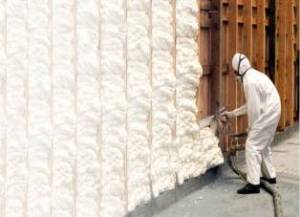
Insulation is an important part of a home. However, in most cases homes do not have enough insulation, and in some cases have no insulation at all. Because insulation is often hidden behind walls and or in places they frequently do not go in a home, homeowners often forget that insulation could be a home improvement project. Adequate insulation of a home can drastically reduce heating and cooling costs for a homeowner, but how do homeowners choose the right insulation for their home?
An R-value is the measure of its thermal resistance to heat flow. Th higher the number the more effective the insulation is at keeping the heat inside of the home. For example, insulation with the R-value of 13 would be less effective than insulation with an R-value of 19. A homeowner should keep in mind that each wall and ceiling can have a different R-value. This can be because of density and other differences between brands.
Types of insulation
Loose Fill – Fiberglass is the most common material used in loose fill insulation because it can be blown in. A truck with a strong blower and a 4-inch diameter hose is necessary. The hose is run to the attic of the home where a technician sprays the loose fill insulation around the attic. An advantage of this type of insulation is that it is easily installed around pipes and on top of existing insulation. Loose fill is also used to insulate empty wall cavities. However, a drawback of this insulation type is that it can only be used in completely contained spaces or areas where gravity holds it in place. Thus, loose fill insulation cannot be used on the ceiling of a crawlspace or an unfinished basement.
Injection Foam – This insulation type comes in the form of a liquid that is injected into walls. The insulation liquid flows freely throughout the wall cavity and conforms around outlets and seals bypasses. The liquid hardens to create a dense barrier that helps prevent air infiltration. Injection foam is recommended for hard to reach areas such as finished walls, crevices, and other irregular areas in a home.
Blanket – For this type of insulation, fiberglass blankets are usually precut into rolls or batts. Batts are specifically sized to fit between wall studs. Blanket type insulation is often used in the building process to insulate walls before they are hung. Fiberglass rolls are commonly used ceilings of basements and crawlspaces. Care needs to be taken during installation of batts. Precise cuts must be made in the rolls so that it fits tightly around the space for light switches, outlets, and other occupied spots in walls. Installing fiberglass rolls or batts over existing insulation is also a challenge as technicians must ensure that the individual blankets do not have gaps between them or that they have their seams aligned.
Radiant Barrier – Also called reflective insulation, Radiant barriers are foils or films that reflect heat back into the direction it came from. This type of insulation can be used in many different areas but is most commonly used in attics where it can be stapled to the underside of roof rafters.
After a loss, consult with AAA Public Adjusters
and schedule a free consultation. Call toll free 800-410-5054 or visit their
website at //aaapublicadjusters.com/.
About AAA Public Adjusters
AAA Public Adjusters, LLC, is a property loss consulting firm headquartered in
Philadelphia, PA. Additional offices are located throughout Pennsylvania, New
Jersey, Maryland, Florida, Delaware, Virginia, and North Carolina. AAA Public
Adjusters have been fighting insurance companies for over 25 years. AAA
Public Adjusters, Maximizing Your
Claim!




